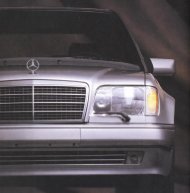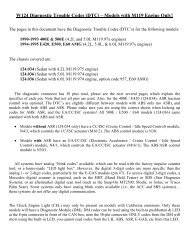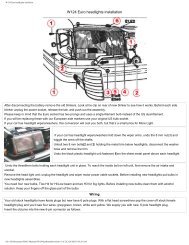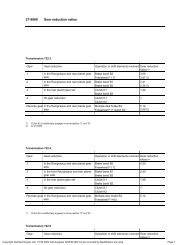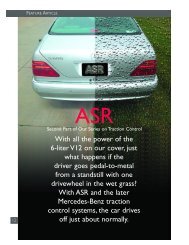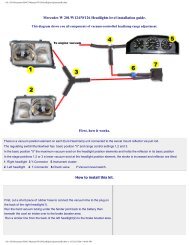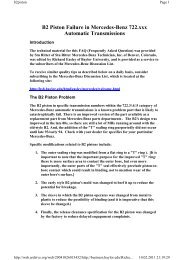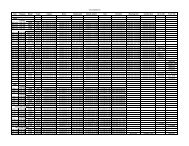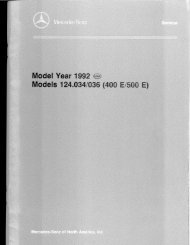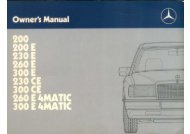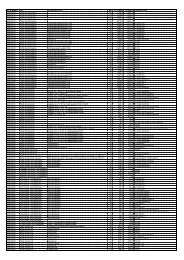You also want an ePaper? Increase the reach of your titles
YUMPU automatically turns print PDFs into web optimized ePapers that Google loves.
OPERATION GUIDE<br />
FOR <strong>BECKER</strong> <strong>1432</strong><br />
Overview<br />
________________________________________________________________________________________________<br />
Prepare to enjoy the many pleasures of listening to a superb sound system:<br />
the Mercedes-Benz AM and FM stereo radio with cassette player. This<br />
Operation Guide is designed to give you both a quick reference of basic<br />
functions and features and a detailed description of the system's entire range<br />
of operation. To maximize your listening satisfaction, take a few minutes to<br />
carefully review all sections of this guide.<br />
Note: The following instructions also include the functions of the optional dealer-installed trunk-mounted<br />
compact disc changer. Not available in station wagon models.<br />
<strong>1432</strong>.doc 1
RADIO FUNCTIONS<br />
BASIC CONTROLS DISPLAY PANEL TUNING<br />
1 Power Button 1 Indicator for Tone Control 1 Wave Band and Station<br />
Recall Buttons<br />
2 Volume Bar 2 Stereo Indicator 2 Function Control Button<br />
3 Bass Control/Balance<br />
Left Button<br />
4 Treble Control/Balance<br />
Right Button<br />
5 Mode Button (Selection of<br />
Operating Mode)<br />
3 Indicator for Tuner<br />
Frequency, Antitheft Code<br />
and Balance Setting<br />
3 Tuning Sensitivity Button<br />
4 Indicator for Selected<br />
Station Recall Button<br />
4 Seek Tuning Bar<br />
5 Wave Band Indicator 5 Scan Tuning Bar<br />
6 Indicator for Tuning<br />
Sensitivity Setting<br />
6 Manual Tuning - Increasing<br />
Station Frequency<br />
7 Manual Tuning - Decreasing<br />
Station Frequency<br />
<strong>1432</strong>.doc 2
CASSETTE PLAYER FUNCTIONS<br />
BASIC CONTROLS DISPLAY PANEL CASSETTE OPERATION<br />
1 Power Button 1 Indicator for Tone Control 1 Reverse Music Search/Fast Rewind<br />
Button<br />
2 Volume Bar 2 Indicator for Antitheft Code,<br />
Balance Setting and Cassette<br />
Functions<br />
3 Bass Control/Balance<br />
Left Button<br />
4 Treble Control/Balance<br />
Right Button<br />
5 Mode Button (Selection of<br />
Operating Mode)<br />
3 Indicator for Dolby® B and C<br />
Button<br />
2 Forward Music Search/Fast Forward<br />
Button<br />
3 Track Selection Button, Eject Button<br />
(Push and Hold)<br />
4 Tape Selection Button<br />
5 Dolby® B and C Button<br />
6 Cassette Port<br />
<strong>1432</strong>.doc 3
COMPACT DISC CHANGER FUNCTIONS<br />
BASIC CONTROLS DISPLAY PANEL CD OPERATION<br />
1 Power Button 1 Indicator for Tone Control 1 Function Control Button<br />
2 Volume Bar 2 Indicator for CD Function 2 Disc Selection Buttons<br />
3 Bass Control/Balance<br />
Left Button<br />
3 Disc Indicator 3 Forward Music Search/Fast<br />
Forward Button<br />
4 Treble Control/Balance 4 Track Indicator 4 Reverse Music Search/Fast<br />
Right Button<br />
5 Mode Button (Selection of<br />
Operating Mode)<br />
Reverse Button<br />
5 Random Track Play Indicator 5 Number of Track Display Button<br />
6 Random Track Play Button<br />
7 Elapsed Playing Time Button<br />
<strong>1432</strong>.doc 4
BASIC CONTROLS<br />
Power: The sound system will<br />
operate with the car's ignition switch<br />
in either the PWR on or off<br />
position. To operate the radio or the<br />
optional CD changer, simply push<br />
the power button located at the lower<br />
left corner of the radio faceplate.<br />
Pushing the power button again will<br />
turn the radio off. A tape cassette can<br />
be played without using the power<br />
button by simply inserting the tape<br />
into the cassette port. As soon as the<br />
cassette is drawn into position, it will<br />
begin to play.<br />
Mode: Pushing this button<br />
repeatedly will cause the radio to<br />
cycle through each of its MODE<br />
operating modes: tuner, cassette<br />
player and CD player (if so<br />
equipped).<br />
Volume: Sound level is adjusted by<br />
means of the volume bar located on the<br />
left side of the radio faceplate. Press<br />
VOLUME upward to increase<br />
volume or downward to decrease<br />
volume.<br />
Speed-Dependent Volume<br />
Adjustment: A special function<br />
adjusts the volume of sound a preset<br />
amount according to vehicle speed.<br />
Thus, increased wind and road noise<br />
are compensated for as the vehicle is<br />
driven faster. When vehicle speed<br />
and thus ambient sound level drop,<br />
the volume is automatically lowered<br />
a preset amount.<br />
Tone: Two tone buttons, identified<br />
by musical notes, are located above<br />
the volume bar. The left button<br />
controls bass, and the right controls<br />
treble. A bar graph at the left of the<br />
radio display indicates relative bass<br />
and treble settings.<br />
To bring both bass and treble tones<br />
to their midrange settings, press both<br />
buttons simultaneously. To bring<br />
either bass or treble tone to<br />
maximum level, press and hold the<br />
respective button. If the button is<br />
d<br />
released and then pressed again, the<br />
tone level will move toward its<br />
minimum level. To reverse<br />
adjustment direction, the maximum<br />
level must be reached first. The<br />
system is equipped with a memory<br />
function that will store the<br />
adjustment tone levels of AM, FM,<br />
cassette and optional CD modes<br />
separately.<br />
p<br />
<strong>1432</strong>.doc 5
Balance: Left-to-right stereo balance is<br />
adjusted using the same buttons that<br />
control bass and treble levels. First press<br />
the function control button, which is on<br />
the right side of the display and marked<br />
with a star "*". To shift sound balance to<br />
the left speakers, press the bass control<br />
button. To shift balance to the right<br />
speakers, press the treble control button.<br />
Balance can be set to the mid-position<br />
by pressing both buttons simultaneously.<br />
A visual indication of the<br />
p<br />
* d<br />
balance setting is provided on the<br />
display when the balance feature is<br />
activated.<br />
Fader: A fader control is provided on<br />
models equipped with both front and<br />
rear speakers. Located on the lower<br />
console near the gear selector, this<br />
thumbwheel control can be adjusted to<br />
suit your preference. Dialing the<br />
thumbwheel forward will increase<br />
output of the front speakers while<br />
reducing that of the rear. Conversely,<br />
dialing the thumbwheel backward will<br />
increase output of the rear speakers,<br />
while reducing that of the front.<br />
Positioning the thumbwheel in its center<br />
detent will equalize sound output.<br />
Antenna: The antenna extends<br />
automatically whenever the radio is<br />
switched on and retracts whenever the<br />
radio or the vehicle's ignition is<br />
switched off.<br />
Power-Off Delay: When you are<br />
listening to the sound system and turn<br />
off the ignition key, the sound system<br />
will continue playing for three seconds.<br />
This allows you sufficient time to turn<br />
the ignition key to the accessory<br />
position without interrupting the<br />
function of the radio, the cassette player<br />
or the optional CD changer.<br />
Battery Conservation: It is possible to<br />
operate the radio when the ignition is off<br />
for up to an hour. After one hour, the<br />
radio will automatically shut itself off to<br />
conserve battery power. If continued<br />
listening is desired, simply press the<br />
power button again.<br />
<strong>1432</strong>.doc 6
Radio Operation<br />
Radio Operation<br />
The radio is capable of receiving<br />
monaural AM broadcasts and<br />
monaural and stereo FM broadcasts.<br />
A stereo indicator will appear on the<br />
radio display whenever an FM stereo<br />
signal is received. To select the wave<br />
band you wish to hear, simply press<br />
any one of the numbered station<br />
recall buttons located along the top<br />
of the radio faceplate-1 through 6 for<br />
FM, 7 through 0 for AM. To tune to<br />
a specific station, use any of the<br />
following methods:<br />
Seek and Scan Tuning: The seek<br />
bar, located on the right side of the<br />
radio faceplate, can be used to tune<br />
SEEK SCAN<br />
in broadcast frequencies within AM<br />
or FM wave bands. Pressing the bar<br />
up will cause the radio to lock onto<br />
stations tracked in ascending<br />
frequencies; pressing it down will<br />
track stations in descending order.<br />
The scan bar, located directly to the<br />
right of the seek bar, allows<br />
sampling of radio stations within a<br />
wave band for approimately five<br />
seconds each. If no action is taken<br />
during the five-second period, the<br />
radio will tune to the next station.<br />
Pressing either the seek bar or the<br />
scan bar a second time will cause the<br />
radio to stay tuned to the station<br />
being sampled.<br />
Sensitivity Control: This feature<br />
enables you to choose two tuning<br />
sensitivity levels by pressing the<br />
sensitivity control button located on<br />
the far right side of the radio<br />
faceplate. The level you select will<br />
be indicated by an L (local) or a D<br />
(distant) appearing on the right side<br />
of the radio display. In the local<br />
mode, the radio will seek and scan<br />
only the strongest signals. In the<br />
distant mode, it will seek and scan<br />
less powerful signals as well. The<br />
sensitivity level is automatically<br />
increased after the entire wave band<br />
has been sampled without finding a<br />
station.<br />
Direct Frequency Tuning: To tune<br />
directly to a specific frequency,<br />
switch to your desired wave band-<br />
AM or FM-as described, then press<br />
the function control button, which is<br />
AM or FM *<br />
identified by a star "*" and located<br />
just to the right of the radio display.<br />
The display will go blank. Next,<br />
press the numbered buttons<br />
corresponding to the digits of your<br />
desired station. For example, to<br />
select the frequency 98.5, you would<br />
first press the function control button<br />
to clear the display. Then you would<br />
press button numbers 9, 8 and 5 in<br />
consecutive order. The display<br />
would then read 98.5, and the station<br />
at that frequency would begin<br />
<strong>1432</strong>.doc 7
playing. The driver, of course,<br />
should not<br />
v ^<br />
use the direct frequency method<br />
when the vehicle is in motion.<br />
Manual Tuning: To <strong>manual</strong>ly tune<br />
through each possible radio<br />
broadcast frequency in ascending<br />
order, press the right <strong>manual</strong> tuning<br />
button. Each possible frequency<br />
number will appear in the display as<br />
you reach it. To <strong>manual</strong>ly tune<br />
through radio stations in descending<br />
order, press the left <strong>manual</strong> tuning<br />
button.<br />
Push-Button Memory Tuning: The<br />
most convenient method of tuning is<br />
to store your favorite stations in the<br />
radio's memory. Six FM stations and<br />
four AM stations may be stored by<br />
using the numbered station recall<br />
buttons located along the top of the<br />
radio faceplate.<br />
First, using either the seek, scan, or<br />
direct frequency tuning methods,<br />
tune in the station you wish to store.<br />
Next, push and hold the numbered<br />
station recall button you wish to use.<br />
The radio will display the station<br />
currently stored at that number.<br />
Continue holding the button until<br />
this station is deleted from memory<br />
and the frequency of your newly<br />
selected station appears on the<br />
display. The new frequency will be<br />
stored in memory.<br />
CASSETTE OPERATION<br />
To play a cassette, insert it into the<br />
cassette port with its side one or A<br />
up and the exposed tape side facing<br />
the port. The cassette will be drawn<br />
automatically into the deck. At the<br />
conclusion of the first side's play, the<br />
auto-reverse mechanism will<br />
automatically begin playing the other<br />
side of the tape.<br />
If a tape has already been loaded but<br />
a different mode (tuner or CD) has<br />
been subsequently selected, press the<br />
mode button until cassette play<br />
resumes.<br />
CR Tape Switch: This feature<br />
allows you to select the proper<br />
equalization setting for playing<br />
chromium dioxide (CrO 2 ) or "metal"<br />
cassette tapes. The radio display will<br />
show CR when this option has been<br />
selected.<br />
<strong>1432</strong>.doc 8
Eject: To remove a cassette, push<br />
and hold the track selection/eject<br />
button until the tape automatically<br />
1 - 2<br />
disengages and can then be retrieved<br />
from the cassette port. Ejecting a<br />
cassette switches the system to radio<br />
operation.<br />
Forward Music Search/Fast<br />
Forward: A cassette tape can be<br />
automatically advanced to the next<br />
selection by pressing the forward<br />
music search button once.<br />
>>I<br />
The radio's display will show MSF<br />
and the current track to indicate that<br />
music search has been activated.<br />
To fast-forward the tape to the end of<br />
the side, press the forward music<br />
search button twice. The radio's<br />
display will show FF and the current<br />
track to indicate the fast-forward<br />
function has been activated.<br />
Reverse Music Search/Rewind: A<br />
cassette tape selection can be<br />
repeated by pressing the reverse<br />
music search button once. The<br />
radio's display will show MSR and<br />
the current track to indicate that<br />
music search has been activated.<br />
Push the button twice to completely<br />
rewind the tape. Once engaged, it<br />
will lock into position until the tape<br />
is fully rewound or until another tape<br />
function is activated.<br />
I
Compact Disc Operation<br />
If the optional dealer-installed CD<br />
changer is connected to your system,<br />
it can be operated via the same keys<br />
that control the radio and cassette<br />
player.<br />
The same instructions that govern<br />
volume, tone and balance in the<br />
radio and cassette modes apply to the<br />
CD mode as well. However, some<br />
system functions and procedures are<br />
exclusive to the CD mode.<br />
Loading the CD Magazine and CD<br />
Changer: The CD changer is inside<br />
the car's trunk. Its magazine will<br />
accept up to ten discs. Insert the<br />
discs into the magazine<br />
compartments with the label surface<br />
facing up.<br />
When the magazine is loaded, place<br />
it into the CD changer port. An<br />
arrow on the top surface of the<br />
magazine indicates which end should<br />
be inserted first. When you feel the<br />
magazine lock snugly into position<br />
in the port, close the port door.<br />
During this procedure, the display<br />
panel will read LOAD M if in CD<br />
mode. Once the CD changer cycles<br />
through the discs in the magazine,<br />
the first CD will play.<br />
Ejecting the CD Magazine: To<br />
eject the magazine from the CD<br />
changer, press the CD port door lock<br />
to open the magazine port door.<br />
Press the magazine eject button<br />
inside the port door and the<br />
magazine will automatically slide<br />
halfway out of the magazine port;<br />
remove the magazine <strong>manual</strong>ly and<br />
close the port door.<br />
To Play CDs: First, turn on the<br />
radio. Press the mode button once or<br />
twice, depending on the operating<br />
mode set before, until CD appears on<br />
the display. If the CD magazine has<br />
not been inserted into the CD<br />
changer or if there are no discs in the<br />
CD magazine, the display will<br />
indicate CD-M-E, meaning CD<br />
Magazine Empty.<br />
The radio's station recall buttons,<br />
numbered 1FM through 0AM,<br />
function as CD disc-select buttons as<br />
well. To play the disc in the CD<br />
magazine's fourth compartment, for<br />
example, press button 4FM.<br />
<strong>1432</strong>.doc 10
Load 4 appears on the display as the<br />
disc is placed into position; the<br />
display changes to CD 14 once the<br />
disc begins to play.<br />
To interrupt one disc and choose<br />
another press the appropriate discselector<br />
button for the disc desired.<br />
The display will read LOAD and the<br />
number of the desired disc until the<br />
newly selected disc begins playing.<br />
Should two horizontal lines appear<br />
on the right side of the display, this<br />
indicates that an empty compartment<br />
in the CD magazine was selected.<br />
Forward Music Search/Fast<br />
Forward: To move from one track<br />
to the next on the same CD, simply<br />
press the forward music search<br />
button. The current track will fade<br />
out, and a moment later the CD's<br />
next selection will begin. Similarly,<br />
to move ahead three selections,<br />
quickly press the key three times.<br />
To move consecutively through<br />
several tracks, press and hold the<br />
forward music search button; in this<br />
way, you can advance as far as the<br />
beginning of the last track on the<br />
disc.<br />
To fast-forward through a given<br />
track, press the function control<br />
button "*" and then the forward<br />
music search button. To help gauge<br />
your progress through a track, the<br />
disc's elapsed playing time will be<br />
indicated on the display.<br />
Reverse Music Search/Fast<br />
Reverse: To repeat an earlier track<br />
on the disc you are listening to, press<br />
the reverse music search button.<br />
Press it once to go back to the<br />
beginning of the selection currently<br />
playing, twice to return to the<br />
beginning of the previous selection,<br />
and so forth.<br />
Press this button for a sustained<br />
period, and you will move<br />
consecutively through several<br />
selections, all the way to the<br />
beginning of the disc, if you choose.<br />
To fast-reverse through a given<br />
selection, press the function control<br />
button "*" followed by the reverse<br />
music search button. To help monitor<br />
how far you have back-tracked<br />
through the selection, the display<br />
will indicate the disc's elapsed<br />
playing time.<br />
Random Track Play: To play the<br />
tracks on a CD in nonconsecutive<br />
order, press the Dolby® B/C button<br />
once. In this mode, the track number<br />
indicated on the display will be<br />
followed by an R to show that<br />
selections are being randomly<br />
chosen. To cancel this command and<br />
return to sequential playing of CD<br />
selections as they are ordered on the<br />
disc, press the Dolby® B/C button<br />
once more.<br />
<strong>1432</strong>.doc 11
Display of Tracks and Playing<br />
Time: To determine the number of<br />
tracks on the selected disc, press the<br />
function control button "*", and then<br />
the tape selection button CR. The<br />
display will indicate the total number<br />
of selections for eight seconds.<br />
Similarly, to determine how long a<br />
disc has been playing, press the<br />
function control button "*", and then<br />
the mode button. A three- or fourdigit<br />
number will appear in the<br />
display - the first one or two<br />
indicating minutes, the second two<br />
indicating seconds. A display<br />
readout of 3417 means the disc has<br />
been playing for thirty-four minutes<br />
and seventeen seconds.<br />
Maintenance Notes for CD<br />
System: Extreme temperatures will<br />
affect the performance of the CD<br />
system. However, optimum<br />
performance will occur between 32<br />
and 140 degrees Fahrenheit.<br />
Dampness on the disc surface can be<br />
caused by changing temperatures and<br />
may affect disc performance,<br />
inhibiting the system's laser from<br />
focusing and making it impossible<br />
for it to read the contents of a disc.<br />
As soon as relative humidity has<br />
decreased, this situation will correct<br />
itself, usually within one or two<br />
hours.<br />
Although compact discs are specially<br />
coated for durability, they should<br />
still be handled carefully. Handle<br />
discs only by the edges and avoid<br />
fingerprints, dust, scratches, and<br />
dampness on both surfaces. Do not<br />
label the discs or affix paper or tape<br />
to them. After removing a disc from<br />
the magazine, store it in its original<br />
case.<br />
If needed, clean the disc with a CD<br />
cleaning cloth, wiping radially from<br />
the center of the disc to the edge. Do<br />
not use solvents such as benzene,<br />
thinner, or commercially available<br />
cleaners intended for analog discs.<br />
Mistracking or skipping due to road<br />
shock is unavoidable but will not<br />
damage the unit or discs.<br />
Caution: This CD player contains<br />
a Class 1 laser unit. If the cover is<br />
opened or damaged, there is<br />
danger from invisible laser<br />
radiation. Do not remove the<br />
cover. There are no parts that can<br />
be repaired by the user. Only<br />
qualified service technicians<br />
should attempt internal<br />
maintenance or repairs.<br />
<strong>1432</strong>.doc 12
High Performance Sound<br />
Standard on all S-Class and SL<br />
models, as well as the 300E, 300E<br />
4MATIC TM and 300 CE * , is a special<br />
High Performance Sound System,<br />
which has been specifically<br />
engineered and equalized for the<br />
interiors of these particular models.<br />
Developing vibrant stereo power by<br />
means of separate audio power<br />
amplifiers, the system plays through<br />
ten high-quality speakers in the S-<br />
Class and 300 Class models: two<br />
low-frequency, two mid-frequency,<br />
four high-frequency and two midhigh-frequency<br />
units. The SL sound<br />
system has six speakers: two lowfrequency,<br />
two mid-frequency, and<br />
two high-frequency units.<br />
*<br />
Optionally available on the 300 D<br />
2.5 Turbo and the 300 E 2.6.<br />
<strong>1432</strong>.doc 13
Antitheft System<br />
The Mercedes-Benz AM and FM<br />
stereo radio with cassette player and<br />
CD compatibility is fitted with a<br />
built-in system designed to help<br />
render it inoperative in case of theft.<br />
If the radio or battery is<br />
disconnected, the radio will be<br />
automatically disabled. To indicate<br />
this state, the word CODE will<br />
appear on the radio's display. To<br />
render the radio operable again, the<br />
correct four-digit code must be<br />
entered into the radio via its<br />
numbered station recall buttons. A<br />
code is preassigned to each radio and<br />
supplied to the owner on two walletsized<br />
cards.<br />
Recoding Sequence: To recode a<br />
radio, follow this procedure: 1. Turn<br />
ignition key to lock position one.<br />
2. Turn on the radio. The word<br />
CODE appears on the display. 3.<br />
Enter the first digit of the radio's<br />
antitheft code as it appears on the<br />
code card. The word CODE will<br />
disappear and the first number that<br />
you have entered will be displayed.<br />
4. Enter the rest of the antitheft code.<br />
Each number will be displayed when<br />
it is keyed in. 5. When all four<br />
antitheft code numbers have been<br />
correctly entered, radio operation<br />
will resume. The station stored at<br />
push-button 1FM will play.<br />
Incorrect Code: If an incorrect<br />
antitheft code digit is entered,<br />
continue to enter numbers until four<br />
are displayed. The word CODE will<br />
appear again. The system allows two<br />
more recoding attempts. After the<br />
third incorrect attempt, the word<br />
WAIT is displayed. A period of 15<br />
minutes must pass and the word<br />
CODE must again be displayed<br />
before recoding can be successful.<br />
The radio must be left ON during<br />
this period. This measure is meant to<br />
prevent a thief from recoding the<br />
radio by randomly entering numbers.<br />
If the correct antitheft code has not<br />
been entered after three separate<br />
attempts-and therefore after two 15-<br />
minute WAIT intervals-the radio will<br />
lock for 24 hours to prevent any<br />
further recoding attempts. The radio<br />
must be left ON during this period in<br />
order for it to reenter the CODE<br />
mode.<br />
Code cards should not be stored in<br />
the glove compartment. During<br />
vehicle service at an authorized<br />
Mercedes-Benz dealer, we<br />
recommend that you leave one card<br />
with your service advisor. Thus, if<br />
the battery is disconnected, the<br />
service advisor can recode the radio<br />
before the car is returned to you.<br />
If the car is equipped with a<br />
Mercedes-Benz antitheft alarm<br />
system, the alarm will sound should<br />
the radio be removed from the<br />
console while the alarm system is<br />
armed. If you have difficulty<br />
reprogramming the radio or if the<br />
reprogramming function fails to<br />
operate, please contact your<br />
authorized Mercedes-Benz dealer.<br />
<strong>1432</strong>.doc 14



